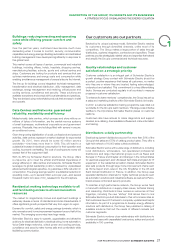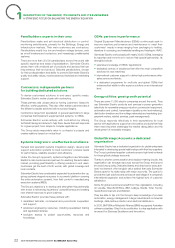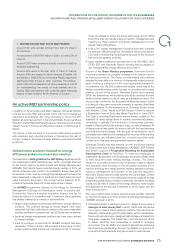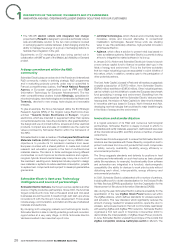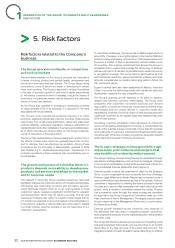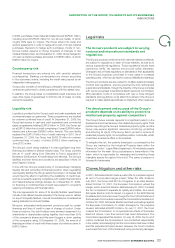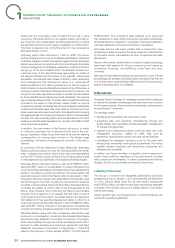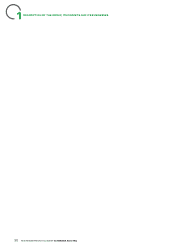APC 2009 Annual Report Download - page 29
Download and view the complete annual report
Please find page 29 of the 2009 APC annual report below. You can navigate through the pages in the report by either clicking on the pages listed below, or by using the keyword search tool below to find specific information within the annual report.
2009 REGISTRATION DOCUMENT SCHNEIDER ELECTRIC 27
DESCRIPTION OFTHEGROUP, ITSMARKETS ANDITSBUSINESSES
1
GROUP ORGANISATION
prototype was designed to meet market expectations for a product
that is easy to install, as it is wireless; reliable, as the switch operates
continuously and requires no maintenance; and green, as there are
no batteries to recycle. What’s more, the switch is less expensive
because there is less wiring.
Recognition and awards
Schneider Electric’s innovations garnered several French and
international nominations and awards during the year.
Three employees of Schneider Electric won the best paper award
from the programme committee at the International Symposium
on Applied Electromagnetics and Mechanics (ISEM) held in Xi’an,
China in September2009. Their paper presented a new method
for evaluating the accuracy of Eddy Current transient analysis in an
electromagnetic simulation, making it possible to improve the design
and energy effi ciency of products in sensor-actuator networks.
The Service Oriented Device Architecture (SODA) project received
the Bronze ITEA Achievement Award at the Information Technology
for European Advancement (ITEA) annual symposium in Madrid in
October2009. According to ITEA, all the projects honored “provided
clear indications of the strong role innovation in information and
communication technology (ICT) is playing in the recovery of the
European economy”. The Board particularly appreciated the fact
that the profi le applicable for low cost devices (DPWS) is open
source and that SODA promoted standardization for DPWS from
the Organisation for the Advancement of Structured Information
Standards (OASIS). This new award comes on top of previous ITEA
wins for the SIRENA project in 2006, which demonstrated that Web
Services could be applied to devices, and the ANSO project in 2008,
which made a signifi cant contribution to the construction of a new
fl exible, interoperable service platform.
>
4. Group organisation
Schneider Electric’s organisation underwent signifi cant modifi cations
in 2009 in line with the One company programme .
The Group started the year with a mixed organisation , comprising
four Operating Divisions with a primarily geographic focus and eight
Business Units covering a certain number of product lines. A simpler,
more straightforward structure was deployed during the year built
around fi ve Businesses, each of which is responsible for its product
line and end-customer segments.
This dual responsibility is a key factor in Schneider Electric’s ambition
to excel simultaneously in two areas: selling products, which requires
clear technological leadership, and selling solutions, which requires
customer intimacy and a detailed understanding of end users’ needs.
This shift towards solutions is a major focus of the One company
programme .
Each of the fi ve Businesses manages its R&D, Marketing and Sales
teams and is responsible for P&L.
A number of back-office functions such as Finance, Human
Resources, IT Systems, Marketing are handled by the Global
Functions, which both have a governance role and provide services
internally.
The fi ve Businesses are:
•Power, which includes Medium and Low Voltage, Installation
Systems and Control, Renewable Energies and four end-
customer segments: Utilities, Marine, Residential and Oil & Gas;
•Industry, which includes Automation & Control and three end-
customer segments: OEMs, Water Treatment and Mining;
•IT, which covers Critical Power & Cooling Services and two end-
customer segments: Information System Manufacturers and
Financial Services;
•Buildings, which includes Building Automation and Security and
four end-customer segments: Hotels, Hospitals, Offi ce Buildings
and Stores;
•CST , a mainly technological business focused on customers in
the Automobile, Aeronautic and Manufacturing industries.
The organisation is deployed in accordance with three key concepts:
•Specialis e : in each country, each Business has its own sales
force and local leader as soon as it reaches critical mass, as well
as its own P&L. In practical terms, this means that each Business
has a specialized front offi ce in each host country to respond
more effectively to customer demand for specifi c expertise. Each
Business is responsible for its overall P&L, both for product sales
in its business lines and the implementation of solutions for end-
customer segments within its scope;
•Mutualise : a Country President is appointed in each country
to oversee the Power Business (and its P&L), deployment of
Schneider Electric’s strategy in the country (including all local
cross-functional issues such as increasing cross-selling among
Businesses) and pooling of local back-offi ce resources. These
resources are gradually brought together in each country or
region under the Country President’s supervision and can include
multiple local support functions—ranging from administration
to project execution—depending on the situation. In addition,
the Country President serves as Schneider Electric’s main
representative in the c ountry, notably in dealings with employees
and local offi cials;
•Globalis e : major support functions that are not specifi c to a
given country or Business are gradually globalized to increase
experience and leverage a signifi cant scale effect. Manufacturing
and Supply Chain operations, areas of shared services or
expertise (such as Finance or Human Resources), Information
Systems and certain Marketing functions (e.g., web services) are
being gradually combined within the Group’s Global Functions.






